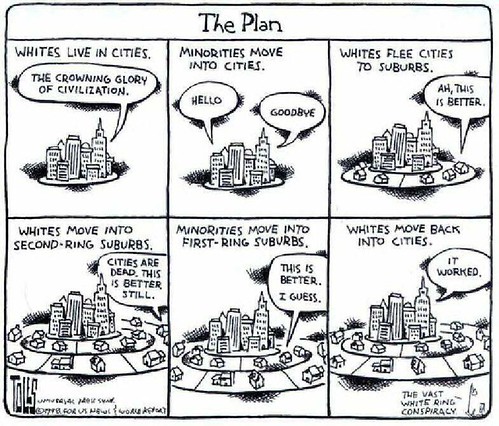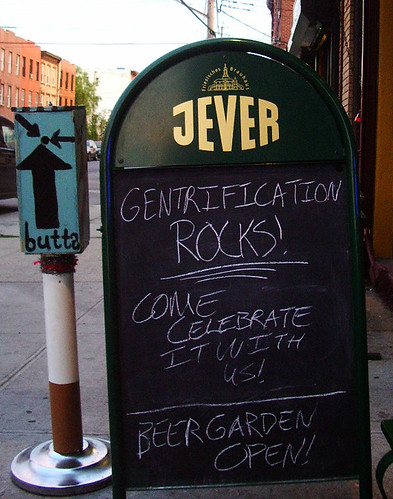Huffington Post Live segment on gentrification (revised)
 Image from Providence, Rhode Island, by abbey*christine, on Flickr.
Image from Providence, Rhode Island, by abbey*christine, on Flickr.Yesterday, I was on Huffington Post Live, in a segment on gentrification, in response to the article "Gentrifier? Who, Me? Interrogating the Gentrifier in the Mirror" from the International Journal of Urban and Regional Research. The article is open access right now.
Here's the link to the segment, which featured one of the authors of the journal article, John Joe Schlichtman, who is now at DePaul University.
Right: a Tom Toles editorial cartoon from 1998 about city in-migration, or "gentrification."
 The authors make the point that most academics writing about gentrification are gentrifiers themselves. They do a good job of unpacking what they call the various pulls that leads people to decide that certain places in the city are attractive places to live, and the signaling that occurs because of the changes.
The authors make the point that most academics writing about gentrification are gentrifiers themselves. They do a good job of unpacking what they call the various pulls that leads people to decide that certain places in the city are attractive places to live, and the signaling that occurs because of the changes.From the article:
Our tool includes six interrelated ‘pulls’ — economic, practical, aesthetic, amenity, social and symbolic — that gentrifiers express feeling and one extraordinary ‘flexibility’ — that for inconvenience — that they seem to possess. These seven indicators are accompanied by what are understood to be three interrelated effects on longer-term residents: displacement, signaling and cultural change.
• economic pull -- it's cheaper (which matters a lot when comparatively speaking, you don't have that much money
• practical pull (I'd call this locational) -- the neighborhood is well-located and convenient
• aesthetic pull -- the building stock is usually historic and potentially attractice
• amenity pull -- there are attractive amenities nearby (hopefully)
• social pull -- desire to either and/or live in a diverse community or live with other gentrifiers
• symbolic pull -- attracted to the neighborhood's identity, authenticity, and historicity
• flexibility pull -- the willingness to deal with inconvenience such as lack of retail amenities, crime, lack of public services, the need to fix your property
 Gentrification rocks, Flickr photo by elevatedprimate.
Gentrification rocks, Flickr photo by elevatedprimate.The point about the interrelated effects is that in-migration changes neighborhoods in many ways, in part by displacement and how presence of different people, by definition, changes the neighborhood and its identity going forward. And the "new people" signal to others that the neighborhood is changing which in turn attracts more residents, investors, and businesses.
No "right to the city" for the middle class
Even though the solution to urban disinvestment is investment, academic discussion of in-migration generally excoriates residential influx as a form of class warfare, that even at the micro level while investment is good at the macro level it's always bad. (E.g., see the past blog post, "Is commercial district revitalization racist?")
 In short, the academic definition of the residential decision-making process takes it as a given that middle class people not originally from "the city" or a neighborhood have "no right to the city" (as opposed to the "Right to the City" as expressed by academics like Henri LeFebvre and David Harvey).
In short, the academic definition of the residential decision-making process takes it as a given that middle class people not originally from "the city" or a neighborhood have "no right to the city" (as opposed to the "Right to the City" as expressed by academics like Henri LeFebvre and David Harvey).It happens that I have written about this also, in "Low income, high income, the market and the right to the city." The post reprints my own unpacking of the gentrification process based on my experiences living in and around the H Street neighborhood from the late 1980s to the middle of the last decade.
And in "Missing the real point: city (re)development isn't about "gentrification" as much as it is about urbanism and urban design."
Labels: gentrification, invasion-succession theory, neighborhood change, urban revitalization



9 Comments:
as someone who was both born here and who is from a family that has lived in this city for a very long time- I take issue with the term "gentrify" because it does not tell the whole story. Left out are the middle class ethnics and working class people who actually built the city and who were for the most part forced out when this city & other cities went downhill and declined. None of this is ever mentioned in the debate about gentrification. It is a two way street for certain- with many sidepaths. The standard bleeding heart picture of gentrification is very one dimensional at best.
True. The arbitrary line for "how the city is and always was" demographically seems to be set to sometime in the 1950s-1970s, depending on the city.
I was talking with a Jewish guy this weekend who was born in DC but raised in Brooklyn, and I think he commented about Anacostia back then being significantly Jewish (of course, there is that old Hebrew cemetery on Alabama Avenue SE...). Of course, that's not what people imagine to be the case.
who "owns" the city? Do the people driving in and double parking for their churches really "own" DC? I hear stories all of the time about these folks telling off newcomers because it is "not your city". However- the way I see it- these people LEFT DC and to me that represents abandonment and no room to manuever.
DC's Jewish heritage was extensive and is not remarked on very much. Yes- I too have heard of the Jewish prescense in Anacostia. DC was an ethnic city no matter what some want to prepetuate and do to misinform. The trouble is that most of the history of DC has been written by transients who chose to live in NW DC and they almost universally omit the working class or SE areas which were in many cases the most interesting of places.
In fiction, I've seen a lot of mentions of Grand Concourse in the Bronx, and how it was the center of Jewish life pre-1960.
FOr the first time, on Friday, I walked a portion of it. I didn't take a photo, but came across a majestic old synagogue that has been used by the 7th Day Adventist Church since 1972(!).
On the Jewish heritage in Anacostia: there's a building at 2nd and Xenia Streets SW (this is far SW, east of the River but west of South Capitol Street) that is presently a Protestant church of some sort but was very obviously built, in the mid-1950s, as a synagogue. The presence of a former synagogue is one thing, but the fact that the Jewish community in far SW DC in the 1950s felt sufficiently secure about the future of their community to build a new synagogue tells a story that's largely been forgotten.
Wow. I will have to check it out.
SW was home to Russian Jews and NW DC was home to mostly German Jews. The SW folks moved over to Anacostia and the NW folks moved up 7th street, out to Silver Spring and then to Bethesda and Rockville. I know a few Jewish families who live in PG who are descendants of the old SW families.They are not as common as in the NW suburbs. My Jr High School was in the upstairs of a synagogue on 13th and Tuckerman NW. It was still active when I was going to school there in 1973-6[ Acton School]
Great information. This works great for me. Thanks for sharing this :)
Post a Comment
<< Home